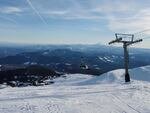
Warm weather has left the Cascades with little to no snow at lower elevations; the only places to ski are at higher elevations.
Wil Kristin/Flickr
With snow levels way below normal, some Northwest ski teams have been scrambling to find slopes with enough snow to hold their scheduled races.
Competitions scheduled for courses at lower elevations on Mount Hood this weekend were either canceled or moved uphill to ski resorts with higher slopes.
Right now, snow levels across the Cascades are about 70 percent below average, according to Andy Bryant, a hydrologist with the National Oceanic and Atmospheric Administration. Warm weather has precipitation falling as rain rather than snow everywhere but the mountain peaks.
Scientists say we might just have to get used to it.
"We're looking at the future right now," said Kathie Dello, associate director of the Oregon Climate Change Research Institute. "With climate change, we're expecting warmer winters and less snowpack, and that's what we have this year."
While you can't tie this year's conditions directly to climate change, Dello said, it's just the kind of winter climate models predict for the Northwest as global temperatures rise.
Scientists are already seeing a long-term trend of shrinking snow pack across the Northwest. Studies have found a 25 percent reduction in snow levels from the middle of last century to 2006.
"Snow is really the smoking gun of climate change in the Northwest," Dello said. "It's where we really see it. With low- to mid-elevation snow pack, just a few degrees of warming makes that transition into more rain and less snow."
Other weather conditions also influence snow levels and winter temperatures, said Amy Snover, director of the Climate Impacts Group at the University of Washington.
That's why the Northwest can still expect to see big snow years – even with climate change. Natural weather variability is likely more responsible for this year's lack of snow than climate change, Snover said. But over time the climate will play a bigger role in how much snow falls in the Northwest.
"As we move forward in time, the contribution of greenhouse gases is going to get bigger and bigger and bigger," she said. "So for this amount of low snow pack in the future a lot more of it is going to be caused by greenhouse gases and it's going to happen a lot more frequently."
Snover said scientist are seeing other long-term trends such as nighttime heat waves and longer frost-free seasons that suggest climate change is already affecting the Northwest.
Low snow pack can lead to water shortage problems, drought and more wildfires come spring and summer, but Bryant said there's still plenty of time left in the season for more snow to fall before those consequences are imminent.
"Certainly, we're not too late at this point," he said. "We can get significant snow in the Cascades all the way through April."
